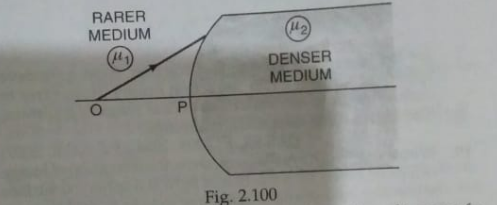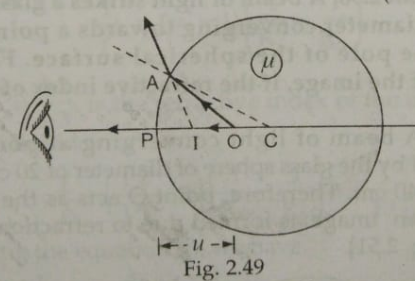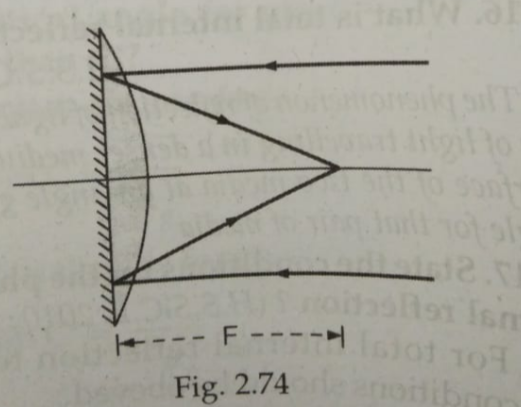EXERCISE from MODERN PUBLICATION Chapter 25 REFRACTION OF LIGHT for Class 12
| Class 12 | PHYSICS |
| Chapter | REFRACTION OF LIGHT |
| MODERN PUBLICATION | EXERCISE |
| Medium | English |
| Academic Year | 2023-2024 |
Question 23
Sparkling Brilliance of Diamond
The total internal reflection of light is used in polishing diamonds to create a sparking briliance. By polishing the diamond with specific cuts, it is adjusted so that most of the light rays approaching the surface are incident with an angle of incidence more than critical angle. hence they suffer multiple reflections and ultimatley come out of the diamond from the top. This gives the diamond a sparkling brilliance.
The following diagram shows the same diamond cut in two different shapes.
The brilliance of diamond in the second diamond will be:View SolutionQuestion 31
The image of a candle is formed by a convex lens on a screen. The lower half of the lens is painted black to make it completely opaque. Draw the ray diargram to show the image formation. How will this image be different from the one obtained when the lens is not painted black?View SolutionQuestion 53
Starting new cartesian sign conventions, derive the relation. −μ1u+μ2v=μ2−μ1R, when refraction occurs from rarer to denser medium at convex spherical refracting surface (μ1<μ2). Where u, v and R are object distance, image distance and radius of curvature of spherical surface respectively.View SolutionQuestion 56
Starting new cartesian sign conventions, derive the relation. −μ1u+μ2v=μ2−μ1R, when refraction occurs from rarer to denser medium at convex spherical refracting surface (μ1<μ2). Where u, v and R are object distance, image distance and radius of curvature of spherical surface respectively.View SolutionQuestion 57
Starting new cartesian sign conventions, derive the relation. −μ1u+μ2v=μ2−μ1R, when refraction occurs from rarer to denser medium at convex spherical refracting surface (μ1<μ2). Where u, v and R are object distance, image distance and radius of curvature of spherical surface respectively.View SolutionQuestion 58
Fig.2.100 shows a convex spherical surface with centre of curature C,separating the two media of refractive indices μ1 and μ2. .
.
Draw a ray diagram showing the formation of imge of a point object O lying on the principal axis.Derive the relationship between the object and image distances in terms of the refractie indices of the wo media and the radius of curvature R of the surface.View SolutionQuestion 59
Fig.2.100 shows a convex spherical surface with centre of curature C,separating the two media of refractive indices μ1 and μ2. .
.
Draw a ray diagram showing the formation of imge of a point object O lying on the principal axis.Derive the relationship between the object and image distances in terms of the refractie indices of the wo media and the radius of curvature R of the surface.View SolutionQuestion 60
Starting new cartesian sign conventions, derive the relation. −μ1u+μ2v=μ2−μ1R, when refraction occurs from rarer to denser medium at convex spherical refracting surface (μ1<μ2). Where u, v and R are object distance, image distance and radius of curvature of spherical surface respectively.View SolutionQuestion 61
Starting new cartesian sign conventions, derive the relation. −μ1u+μ2v=μ2−μ1R, when refraction occurs from rarer to denser medium at convex spherical refracting surface (μ1<μ2). Where u, v and R are object distance, image distance and radius of curvature of spherical surface respectively.View SolutionQuestion 64
Fig.2.100 shows a convex spherical surface with centre of curature C,separating the two media of refractive indices μ1 and μ2. .
.
Draw a ray diagram showing the formation of imge of a point object O lying on the principal axis.Derive the relationship between the object and image distances in terms of the refractie indices of the wo media and the radius of curvature R of the surface.View SolutionQuestion 69
Starting new cartesian sign conventions, derive the relation. −μ1u+μ2v=μ2−μ1R, when refraction occurs from rarer to denser medium at convex spherical refracting surface (μ1<μ2). Where u, v and R are object distance, image distance and radius of curvature of spherical surface respectively.View SolutionQuestion 70
Starting new cartesian sign conventions, derive the relation. −μ1u+μ2v=μ2−μ1R, when refraction occurs from rarer to denser medium at convex spherical refracting surface (μ1<μ2). Where u, v and R are object distance, image distance and radius of curvature of spherical surface respectively.View SolutionQuestion 71
Starting new cartesian sign conventions, derive the relation. −μ1u+μ2v=μ2−μ1R, when refraction occurs from rarer to denser medium at convex spherical refracting surface (μ1<μ2). Where u, v and R are object distance, image distance and radius of curvature of spherical surface respectively.View SolutionQuestion 72
Starting new cartesian sign conventions, derive the relation. −μ1u+μ2v=μ2−μ1R, when refraction occurs from rarer to denser medium at convex spherical refracting surface (μ1<μ2). Where u, v and R are object distance, image distance and radius of curvature of spherical surface respectively.View SolutionQuestion 93
A tank is filled with water to a height of 12.5 cm. The apparent depth of a needle lying at the bottom of the tank is measured by a microscope to be 9.4 cm. What is the refractive index of water? If water is replaced by a liquid of refractive index 1.63 up to the same height, by what distance would the microscope have to be moved to focus on the needle again?View SolutionQuestion 94
Calculate the index of refraction of a liquid from the following into glass:
Reading for the bottom of an empty beaker:11.324 cm .
Reading for the bottom of the beaker,when partially filled with the liquid:11.802 cm
Reading for the upper level of the liquid in the beaker:12.895 cm.View SolutionQuestion 95
While determining th refractive index of a liquid experimentally, he miroscope was focussed at the bottom of a beaker,when its reading was 3.965 cm.On pouring liquid upto a height of 2.537 cm inside the beaker ,the reading of the refocussed microscoe was 3.348 cm.Find the refractive index of the liquid.View SolutionQuestion 96
The bottom of a container is a 4.0 cm thick glass (μ=1.5) slab. The container contains two immiscible liquids A and B of depths 6.0 and 8.0 cm respectively. What is the apparent position of a scratch on the outer surface on the bottom of the glass slab, when viewed through the container? Refractive indices of A and B are 1.4 and 1.3 respectively.View SolutionQuestion 103
One end of a cylinrical rod is grounded to a hemispherical surface or rdius R=20 mm.It is immersed in water of refractive ndex 1.33.If the refractive index of the rodd is 1.50,find the position of the image of an object placed on the axis of the rod inside water at 10 cm from the pole.View SolutionQuestion 105
A small object is enclosed in a spere of glass 7 cm in radius .It si situated 1 cm from the centre and is veiwed from the side to whh it is nearest.where will it appear to be ,if refractive index is 1.4?Also find the appparent position of the oject as seen by an eye looking laong diameter throug greatest thickness of eh glass.View SolutionQuestion 106
Fig.2.49 shows a solid glass sphere of radius 5 cm that has a small air bubble O trapped at a distance 2 cm from the centre C.Th refractive index of the material of glass is 1.5.Find the apparent position of the bubble where it will appear ,when seen throught the surface from an ougtside point E. .View Solution
.View SolutionQuestion 109
A concave spherical surface of refractive index 3/2 is immersed in water of refracitve index 4/3.If a piont object lies in water at a distance of 10 cm from the pole of the refracting surfae,calculate the position of the image.Given that radius of curvature of the spherical surface is 18 cm.View SolutionQuestion 138
A convex lens of focal lenght 20 cm is placed coaxially wih a convex mirror of radius of curvature 20 cm.the two are kept at 15 cm apart.A point object lies 60 cm in front of the convex lens.Draw a ray diagram to show the formation of the image by the combination.Determine the nature and position of the image formed.View Solution
 .
.